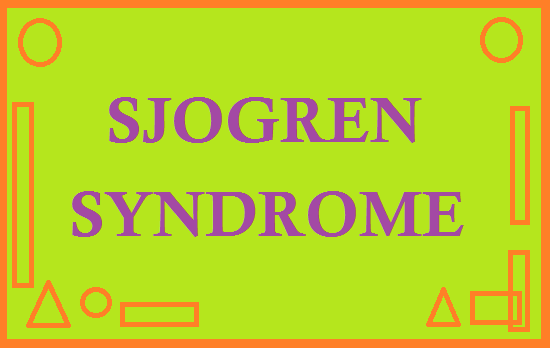SJOGREN SYNDROME
Sjogren syndrome is a systemic autoimmune disorder whose clinical findings is usually dominated by dryness of the eyes and mouth due to immune mediated dysfunction of the salivary gland and lacrimal glands. The disorder is mostly seen in women, usually occurs between the ages of 40-60 years. Sjögren syndrome can occur in isolation or in association with another rheumatic disease. Sjögren syndrome is most frequently associated with rheumatoid arthritis but also occurs with SLE, primary biliary cholangitis, polymyositis, Hashimoto thyroiditis, scleroderma, polyarteritis, and interstitial pulmonary fibrosis.
SYMPTOMS
Keratoconjunctivitis sicca results from inadequate tear production caused by lymphocyte and plasma cell infiltration of the lacrimal glands. Ocular symptoms are usually mild. Burning, itching, and the sensation of having a foreign body or a grain of sand in the eye occur commonly. For some patients, the initial manifestation is the inability to tolerate wearing contact lenses. Many patients with more severe ocular dryness notice ropy secretions across their eyes, mostly in the morning.
Photophobia may indicate for corneal ulceration resulting from severe dryness. For most patients symptoms of dryness of the mouth (xerostomia) dominate those of dry eyes. Patients frequently complain of a “cotton mouth” sensation and difficulty swallowing foods, especially dry foods like crackers, unless they are washed down with liquids. . A few patients have such severe xerostomia that they have difficulty speaking. Persistent xerostomia results often in rampant dental caries, and caries at the gum line strongly suggest Sjögren syndrome.
Some patients are most troubled by loss of taste and smell. Parotid enlargement which may be chronic or relapsing. Dryness may involve the nose, throat, larynx, bronchi, vagina, and skin. Systemic manifestations include dysphagia, small vessel vasculitis, pleuritis, obstructive airways disease and interstitial lung disease (in the absence of smoking), neuropsychiatric dysfunction (most commonly peripheral neuropathies), and pancreatitis; they may be related to the associated diseases noted above. Renal tubular acidosis (type 1, distal) occurs in 20% of patients. Chronic interstitial nephritis, which may result in impaired kidney function, may also be occurs.
DIAGNOSIS
Isolated complaints of dry mouth are most commonly due to medication side effects. Chronic hepatitis C can cause sicca symptoms and rheumatoid factor positivity. Minor salivary gland biopsies reveal lymphocytic infiltrates but not to the extent of Sjögren syndrome, and tests for anti-SS-A and anti- SS-B are negative. Involvement of the lacrimal or salivary glands, or both in sarcoidosis can mimic Sjögren syndrome; biopsies reveal noncaseating granulomas. Rarely, amyloid deposits in the lacrimal and salivary glands produce sicca symptoms. IgG4-related systemic disease (characterized by high serum IgG4, levels and infiltration of tissues with IgG4 plasma cells) can result in lacrimal and salivary gland enlargement that mimics Sjögren syndrome.
LABORATORY FINDINGS
Laboratory findings include mild anemia, leukopenia, and eosinophilia. Polyclonal hypergammaglobulinemia, rheumatoid factor positivity (70%), and antinuclear antibodies (95%) are all common findings. Antibodies against SS-A and SS-B (also called Ro and La, respectively) are often present in primary Sjögren syndrome and tend to correlate with the presence of extra-glandular manifestations.
Thyroid-associated autoimmunity is a common finding among patients with Sjögren syndrome. Useful ocular diagnostic tests include the Schirmer test, which measures the quantity of tears secreted. Lip biopsy, a simple procedure, reveals characteristic lymphoid foci in accessory salivary glands. Biopsy of the parotid gland should be reserved for patients with atypical presentations such as unilateral gland enlargement that suggest a neoplastic process.

TREATMENT
Treatment of sicca symptoms is symptomatic and supportive. Artificial tears applied frequently will relieve ocular symptoms and avert further desiccation. Topical ocular 0.05% cyclosporine also improves ocular symptoms and signs of dryness. The mouth should be kept well lubricated. Sipping water frequently or using sugar-free gums and hard candies usually relieves dry mouth symptoms.
Pilocarpine (5 mg orally four times daily) and the acetylcholine derivative cevimeline (30 mg orally three times daily) may improve xerostomia symptoms. Atropinic drugs and decongestants which decrease salivary secretions and should be avoided. A program of oral hygiene, including fluoride treatment, is essential in order to preserve dentition. If there is an associated rheumatic disease, its systemic treatment is not altered by the presence of Sjögren syndrome.
Although Sjögren syndrome may compromise patients’ quality of life significantly, the disease is usually consistent with a normal life span. Poor prognoses are influenced mainly by the presence of systemic features associated with underlying disorders, the development in some patients of lymphocytic vasculitis, the occurrence of a painful peripheral neuropathy, and the complication (in a minority of patients) of lymphoma. Severe systemic inflammatory manifestations are treated with prednisone or various immunosuppressive medications.
The patients at greatest risk for developing lymphoma are those with severe exocrine dysfunction, marked parotid gland enlargement, splenomegaly, vasculitis, peripheral neuropathy, anemia, and mixed monoclonal cryoglobulinemia.
For Informational purpose only. Consult your Physician for advice.